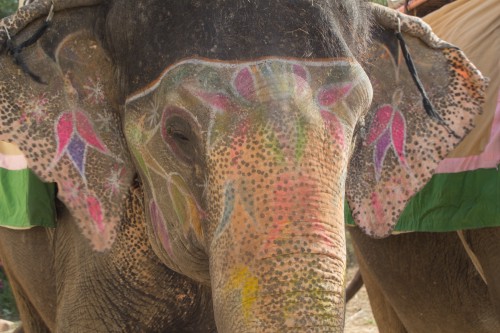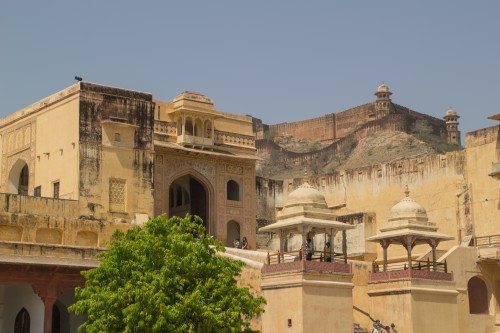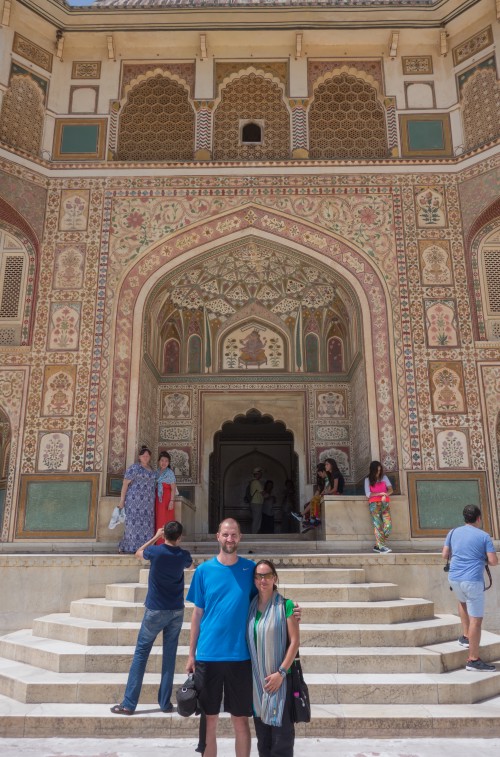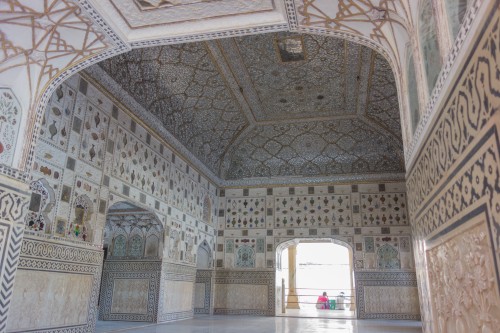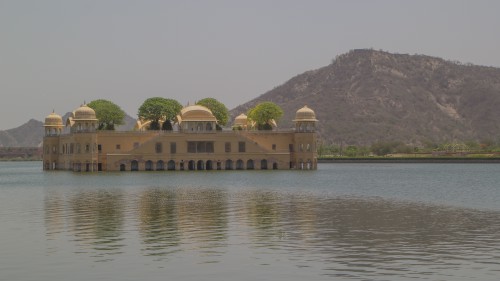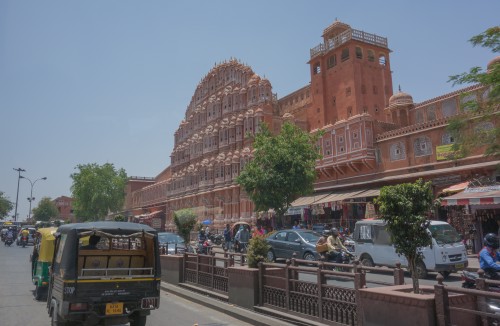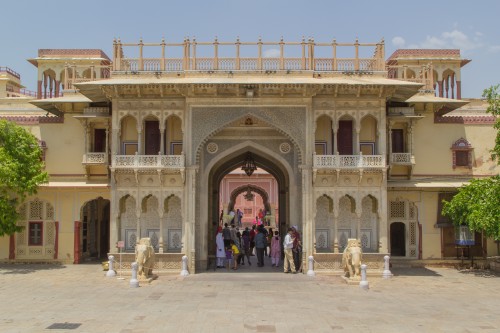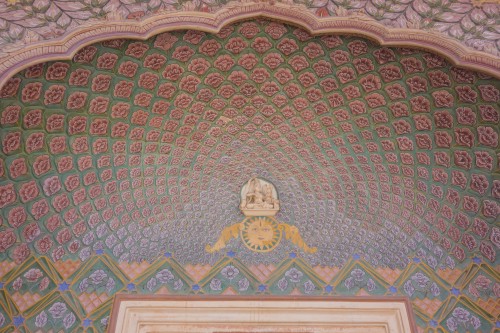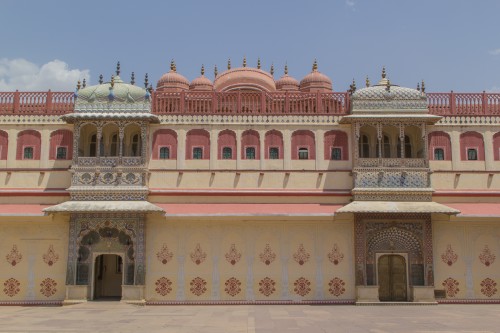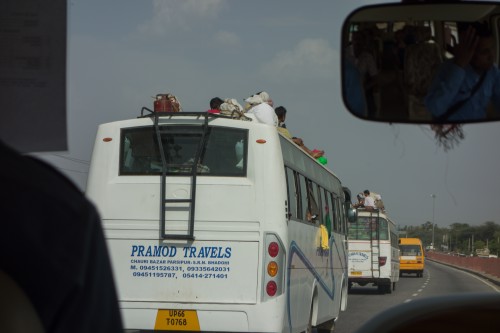We got up around 7 today, one of our latest wake-ups all trip. Our first stop would be at an elephant sanctuary. We left for there at 7:30. It was "standard fare," as we just got on the elephants and the walked around, posed for some pictures, etc. We'd done this in Thailand and in Zambia, but it was the first time for Dewey and Clarita. Getting on the elephant was much easier than in Zambia, as there was a giant concrete staircase and platform to get up to the top of the elephants - in Zambia we actually had to climb on a giant male elephant. The "saddle" on the elephant was very small, and Justin's legs kept hanging off the sides. After getting off the elephants, we had a nice breakfast at the site, with a couple of dogs (who resembled our dogs Meth and Cabo) and a cat that was marked like a tiger stalking for dropped food.
 |
We headed from the elephant sanctuary to the Amber Fort. We knew the Amber Fort was the main attraction in Jaipur, but we didn't really know anything about it. Driving towards it, we were very surprised by giant wall surrounding the area, like a mini "great wall." The path into the fort had lots of zigzags in the roard - apparently this was to confuse intruders into which was the correct way to go. Also, the entry doors had short doors (about 4' tall) in them, and most of the time the huge entry doors were closed and only the small doors were open. Intruders would have to duck to enter, and when they ducked the guards would cut off their heads. Nowadays, the big doors are open. And they are big doors, large enough for elephants to enter, as that is how royalty would come here back in the day. Indeed, there was a three-tiered platform for where people would exit their respective transportation, whether it be horse (short), camel (medium), or elephant (tall).
 |
Amber Fort was built by Raja Man Singh I in the late 1500s. The fort is part of a larger complex that includes Jaigarh Fort, which is located even farther up on the hill and connected by a subterranean passage. While Jaigarh Fort is more of a pure defense fort, Amber Fort contains a massive palace, other living areas, and overlooks Maota Lake. The palace has a four level layout, with each level having its own courtyard. The palace was the residence of the Rajput Maharajas and their families. We came in at the main courtyard, went up some stairs to a second courtyard where we visited the Sheesh Mahal (mirror palace), Ganesh Pol (whose gate was the most decorated part of the entire complex), and the Diwan-i-Am (public audience hall), which had a number of colonnades. The third courtyard included the private quarters of the Maharaja, a garden, and an "AC unit" that was comprised of a piped water supply flowing through an open channel to keep things cool - workers constantly brought water from the bottom back up to the top, as a human pump. The fourth courtyard is where the women (royal family women, concubines, and mistresses) all lived.
 |
We were there well over an hour, even though the jeep driver was supposed to wait only one hour for us to finish. At the very end, on the way back to the jeep, we saw a snake charmer, and Justin tried his luck at snake charming - he made it out alive. We took a short drive to take a quick look at the water palace - a palace built on pylons in the middle of a lake. Then we did another drive-by, this time of the Hawa Mahal (Palace of the Winds), an intricately designed facade in downtown Jaipur constructed of red and pink sandstone. The intention of the facade was to allow royal ladies to observe everyday life in the street below without being seen, since they had to observe strict "purdah" (face cover). We had expected to see a lot more red and pink sandstone, as two trips ago when we were at Bantay Srei (near Angkor Wat) in 2012, we were told that most people think the sandstone there came from Jaipur way back when. There was some reddish pink sandstone buildings in Jaipur, but not as many as we thought we'd see.
 |
 |
After the drive-by, we went to Jantar Mantar, which is a very interesting astronomical observatory place. It has a massive equinoctial sundial, consisting a gigantic triangular gnomon with the hypotenuse parallel to the Earth's axis. On either side of the gnomon is a quadrant of a circle, parallel to the plane of the equator. The instrument is intended to measure the time of day, correct to half a second and declination of the Sun and the other heavenly bodies. It was really interesting to see this and all of the other scientific instruments, but the heat was starting to get to us so we mostly viewed things from the shade. We then walked over to the City Palace Museum, which was almost right next door. Our guide (we sadly can't remember his name) took us around the textile room, the armoury, the dancing courtyard, some massive silver jars that transported water all the way to London, and a large indoor meeting area. By the end of this, everyone but Crystal was exhausted.
We begged to get something to eat or drink, so we grabbed "lunch" at Raj Palace - ice cream and cold drinks, plus air conditioning. We felt infinitely better thereafter, and headed over to a gemstone store. Jaipur is famous for its cutting and shaping of gemstones, and it imports rough stones from all over the world, cuts, shapes and polishes them, and then exports back to wherever. Coincidentally, while we didn't get a chance to look for any tanzanite when we were in Tanzania last fall, all of the tanzanite is shipped to Jaipur and then shipped back to Tanzania when the stones are ready. So we looked at some tanzanite, and it looked nice, but neither of us wears any jewelry, and we couldn't justify buying a stone as a memento, even at wholesale prices. Not wearing jewelry is a very good "out" for getting the owners to stop convincing you to by something. From the gem store, we headed back to the hotel and got cleaned up, then headed over to the bar around 5pm. At 6pm we met Dewey and Clarita in the restaurant where the chef was giving a spice talk, discussing various spices used in Indian cooking and how those spices are best used for cooking and for medicinal purposes. It was very interesting, but there were two other ladies listening to the talk who kept interrupting and asking the chef to repeat what he just said - if they just paid closer attention, the talk would have been only half as long. We grabbed dinner right after the talk, grabbed a drink after that, and then headed back to the room.

